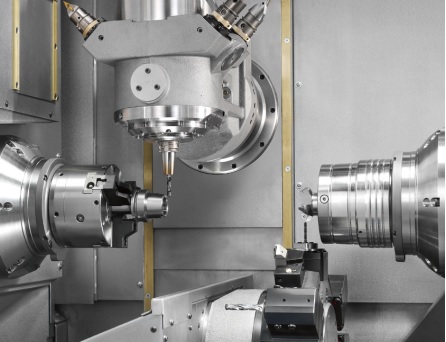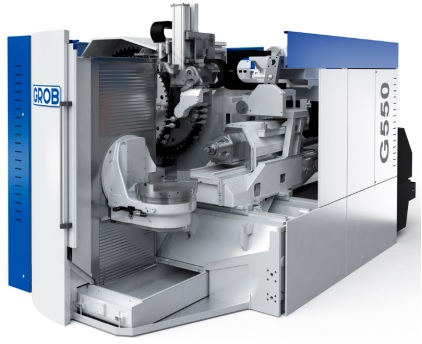What is A Turning and Milling Machine? Advantages of Turning and Milling Machine
What is a turning and milling machine?
A turning and milling machine refers to a machine that can perform both turning and milling, and can be used as both a lathe and a milling machine. The turning and milling machine was first used to process propellers, mainly to avoid the loss of precision and reference loss caused by the second clamping.
The turning and milling machine is a main model of the compound processing machine. In addition to the functions of the CNC lathe, it can also complete surface milling, drilling, tapping, straight groove, spiral groove and milling, etc., with turning, milling and Composite functions such as boring can realize the processing concept of one clamping and complete completion. It is one of the most rapidly developing processing methods in recent years.

Generally, turning and milling machines have the following two features:
1. The spindle motor adopts a servo motor, and the rotation movement and feed movement of the spindle can be linked.
2. In addition to the turret tool post equipped with CNC lathes, at least a power tool or an independent power tool post should be equipped.
Advantages of turning and milling machine
Compared with the milling machine, turning and milling machines have the following advantages.
1. Reduce the number of clamping and improve processing accuracy
The reduction in the number of card loading avoids the accumulation of errors due to the conversion of positioning benchmarks. At the same time, most of the current turning-milling composite processing equipment has the function of online detection, which can realize the in-position detection and precision control of key data in the manufacturing process, thereby improving the processing accuracy of the product; the high-strength integrated bed design improves the difficulty Gravity machining ability of cutting materials.
The turning and milling machine allows all the tools to be processed to complete all boring, turning, drilling, and milling processes in one clamping process, so that the trouble of replacing the machine tool can be greatly avoided. Shorten the cycle of workpiece production and processing to avoid problems caused by repeated clamping.
Turning and milling machine tools can be equipped with a variety of special tools, new tool arrangement, reduce tool change time, improve processing efficiency, can complete all or most of the processing procedures in one clamping, thereby greatly shortening the product manufacturing process chain. In this way, on the one hand, the production assistance time caused by the change of the installation card is reduced, and the manufacturing cycle and waiting time of the tooling fixture are also reduced, which can significantly improve the production efficiency.

2. Intermittent cutting
The turning-milling composite machining method is an intermittent cutting method. This type of intermittent cutting allows the tool to have more cooling time, because no matter what material is processed, the temperature reached by the tool during cutting is lower. During turning and milling, the tool performs intermittent cutting, which can obtain relatively short cuts for workpieces formed of any material, and is easy to automatically remove chips. In addition, the intermittent chips can allow the tool to have sufficient time to cool down, reduce the thermal deformation of the workpiece, and can also increase the service life of the tool. Compared with ordinary milling machines, turning and milling has a higher speed, better quality of cut products, reduced cutting force, improved precision of thin-walled rods and slender rods, and high quality of workpiece forming.
3. Easy to high-speed cutting
The turning-milling composite machining technology is easier to perform high-speed cutting, and its cutting force is reduced by 30% compared with the traditional high cutting, and the reduced cutting force can just reduce the radial force of the workpiece deformation, which can be beneficial for fine processing. Long type precision parts and increase the processing speed of thin-walled parts, and if the cutting force is relatively small, the burden on the tool and the machine tool is also relatively small, so that the accuracy of the turning and milling machine can be better protected.
4. Low workpiece speed
Since the cutting speed can be decomposed into the rotation speed of the workpiece and the rotation speed of the tool, according to the mechanical characteristics, the same processing effect can be achieved by increasing the rotation speed of the tool and reducing the rotation speed of the workpiece. This feature is particularly for the processing of large forgings. Effective, because the reduction of the forging blank speed can eliminate the vibration or the periodic change of the radial cutting force caused by the eccentricity of the workpiece, thereby ensuring the smooth cutting of the workpiece and reducing the error in the processing of the workpiece. If the workpiece speed is relatively low, the object will not be deformed due to centrifugal force when processing thin-walled parts, which is beneficial to improve the machining accuracy of the parts. The use of larger longitudinal feed in turning and milling can also obtain accurate cutting, and the surface roughness can also be effectively guaranteed.
5. Small thermal deformation
When using a turning and milling machine, the entire cutting process is already insulated, so the tool and chips take away a lot of heat, and the temperature of the tool will be lower and thermal deformation will not occur easily.
6. Reduce bending deformation
Using the dual-spindle turning-milling composite machining method can greatly reduce the bending deformation of the parts, especially when processing some thin and long parts that cannot be supported in the middle.


